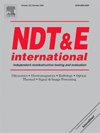Time domain extraction method of ultrasonic nonlinear coefficient
IF 4.1
2区 材料科学
Q1 MATERIALS SCIENCE, CHARACTERIZATION & TESTING
引用次数: 0
Abstract
During the extraction of the fundamental and second harmonic components, factors such as noise, spectral leakage, and the picket fence effect can reduce the accuracy of the ultrasonic nonlinearity coefficient β calculated using the Fast Fourier Transform (FFT) method. To address this issue, two time-domain extraction methods, Supplementary Zero Least Squares (SZ-LS) and Reduction of Noise Preprocessing Prony (RN-Prony) are proposed. The SZ-LS method employs supplementary zero on the truncated signal, ensuring that the number of data points satisfies an integer multiple relationship between the frequency resolution and the fundamental frequency, thereby reducing the impact of picket fence effect on the accuracy of the least squares calculation. The RN-Prony method utilizes The Fast Empirical Wavelet Transform (FEWT) to reduce noise in the signal, followed by Prony's method to calculate the amplitudes of the fundamental and second harmonic components. Simulation studies demonstrate that SZ-LS offers higher accuracy than FFT, but its results still fail to accurately obtain β within the error limits when the number of signal cycles is large. RN-Prony effectively reduces the influence of noise, improving the SNR of the processed signal by average of 54 % compared to the original signal, and achieves higher accuracy than the other two methods. The SZ-LS, RN-Prony and FFT methods are then applied to a set of martensitic stainless steel fatigue specimens and 6061-T6 aluminum alloy tensile specimens where the changes in the ultrasonic nonlinearity coefficient β with the degree of failure are determined. The β parameters processed with the RN-Prony method produce trends that make better physical sense than those processed with the SZ-LS method and FFT.
超声非线性系数的时域提取方法
在提取基频和次谐波分量时,噪声、频谱泄漏和尖桩栅栏效应等因素会降低快速傅里叶变换(FFT)方法计算超声非线性系数β的精度。为了解决这一问题,提出了两种时域提取方法:补充零最小二乘(SZ-LS)和降噪预处理proony (rn - proony)。SZ-LS方法对截断的信号进行补零,保证了数据点个数满足频率分辨率与基频之间的整数倍关系,从而降低了尖桩栅栏效应对最小二乘计算精度的影响。RN-Prony方法利用快速经验小波变换(Fast Empirical Wavelet Transform, FEWT)去除信号中的噪声,然后利用Prony方法计算基频和次谐波分量的幅值。仿真研究表明,SZ-LS比FFT具有更高的精度,但当信号周期数较大时,其结果仍不能在误差限制内准确获得β。RN-Prony有效地降低了噪声的影响,处理后信号的信噪比比原始信号平均提高了54%,精度高于其他两种方法。将SZ-LS、RN-Prony和FFT方法分别应用于马氏体不锈钢疲劳试样和6061-T6铝合金拉伸试样,测定了超声非线性系数β随破坏程度的变化。用RN-Prony方法处理的β参数比用SZ-LS方法和FFT方法处理的β参数产生的趋势具有更好的物理意义。
本文章由计算机程序翻译,如有差异,请以英文原文为准。
求助全文
约1分钟内获得全文
求助全文
来源期刊

Ndt & E International
工程技术-材料科学:表征与测试
CiteScore
7.20
自引率
9.50%
发文量
121
审稿时长
55 days
期刊介绍:
NDT&E international publishes peer-reviewed results of original research and development in all categories of the fields of nondestructive testing and evaluation including ultrasonics, electromagnetics, radiography, optical and thermal methods. In addition to traditional NDE topics, the emerging technology area of inspection of civil structures and materials is also emphasized. The journal publishes original papers on research and development of new inspection techniques and methods, as well as on novel and innovative applications of established methods. Papers on NDE sensors and their applications both for inspection and process control, as well as papers describing novel NDE systems for structural health monitoring and their performance in industrial settings are also considered. Other regular features include international news, new equipment and a calendar of forthcoming worldwide meetings. This journal is listed in Current Contents.
 求助内容:
求助内容: 应助结果提醒方式:
应助结果提醒方式:


